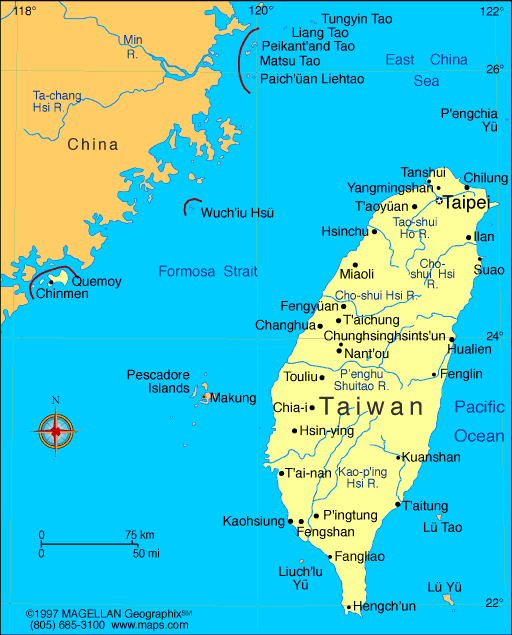TAIWAN

Geography: The Republic of China today consists of the island of Taiwan, an island 100 mi (161 km) off the Asian mainland in the Pacific; two off-shore islands, Kinmen (Quemoy) and Matsu; and the nearby islets of the Pescadores chain. It is slightly larger than the combined areas of Massachusetts and Connecticut.
Government: Multiparty democracy.
History: Taiwan was inhabited by aborigines of Malayan descent when Chinese from the areas now designated as Fukien and Kwangtung began settling it in the 7th century, becoming the majority. The Portuguese explored the area in 1590, naming it “the Beautiful” (Formosa). In 1624 the Dutch set up forts in the south, the Spanish in the north. The Dutch forced out the Spanish in 1641 and controlled the island until 1661, when Chinese general Koxinga took it over and established an independent kingdom. The Manchus seized the island in 1683 and held it until 1895, when it passed to Japan after the first Sino-Japanese War. Japan developed and exploited Formosa. It was the target of heavy American bombing during World War II, and at the close of the war the island was restored to China.
After the defeat of its armies on the mainland, the Nationalist government of Generalissimo Chiang Kai-shek retreated to Taiwan in Dec. 1949. Chiang dominated the island, even though only 15% of the population consisted of the 1949 immigrants, the Kuomintang. He maintained a 600,000-man army in the hope of eventually recovering the mainland. Beijing viewed the Taiwanese government with suspicion and anger, referring to Taiwan as a breakaway province of China.
The UN seat representing all of China was held by the Nationalists for over two decades before being lost in Oct. 1971, when the People's Republic of China was admitted and Taiwan was forced to abdicate its seat to Beijing.

Map of Taiwan
President: Ma
Ying-jeou (2008)
Premier:
Mao Chi-kuo (2014)
Land area: 12,456 sq mi (32,261 sq km);
total area: 13,892 sq mi (35,980 sq km)
Population (2014 est.): 23,359,928 (growth
rate: 0.25%); birth rate: 8.55/1000; infant mortality rate: 4.49/1000;
life expectancy: 79.84
Capital (2014 est.):
Taipei, 6,950,646 (metro. area), 2,693,672 (city
proper)
Other large cities:
New Taipei, 3,913,595; Kaohsiung, 2,773,855; Taichung, 2,662,770; Tainan, 1,876,706; Hsinchu,
419,384
Monetary unit: New Taiwan
dollar
National
name: Zhonghua Minguo
Languages:
Chinese (Mandarin, official), Taiwanese (Min),
Hakka dialects
Ethnicity/race:
Taiwanese (including Hakka) 84%, mainland
Chinese 14%, aborigine 2%
Religions:
mixture of Buddhist, Confucian, and Taoist 93%,
Christian 4.5%, other 2.5%
Literacy
rate: 96.1% (2003)
Economic summary:
GDP/PPP (2013 est.): $926.4 billion; per capita $39,600.
Real growth rate: 2.2%. Inflation: 1.1%.
Unemployment: 4.1%. Arable land: 24%.
Agriculture: rice, vegetables, fruit, tea, flowers, pigs, poultry, fish. Labor force (2013 est.): 11.55 million; agriculture 5%,
industry 36.2%, services 58.8% (2012 est). Industries: electronics,
communications and information technology products, petroleum
refining, chemicals, textiles, iron and steel, machinery, cement, food
processing, vehicles, consumer products,
pharmaceuticals. Natural resources: small deposits of coal,
natural gas, limestone, marble, asbestos. Exports:
$305.8
billion (2013 est.): electronics, flat panels, machinery;
metals; textiles, plastics, chemicals; optical, photographic, measuring,
and medical instruments. Imports: $268.5 billion (2013 est.): electronics, machinery, crude petroleum, precision instruments, organic chemicals, metals
Major trading partners: China, U.S., Hong Kong, Japan,
Singapore (2012).
Communications:
Telephones: main lines in use: 15.998 million (2012); mobile
cellular: 29.455 million (2011). Broadcast media: free-to-air
nationwide television networks operating roughly 75 TV stations; about
85% of households utilize multi-channel cable TV; national and regional
radio networks with about 170 radio stations broadcasting (2008) Internet hosts: 6.272 million (2012). Internet users: 16.147 million
(2009).
Transportation: Railways:
total: 1,580 km (2010). Highways: total:
41,475 km; paved: 41,033 km (including 720 km of expressways);
unpaved: 442 km (2009). Ports and harbors: Chilung
(Keelung), Hualien, Kaohsiung, Taichung. Airports:
37 (2013).
International disputes:
involved in complex dispute with Brunei, China, Malaysia,
the Philippines, and Vietnam over the Spratly Islands, and with China
and the Philippines over Scarborough Reef; the 2002 "Declaration on the
Conduct of Parties in the South China Sea" has eased tensions but falls
short of a legally binding "code of conduct" desired by several of the
disputants; Paracel Islands are occupied by China, but claimed by
Taiwan and Vietnam; in 2003, China and Taiwan became more vocal in
rejecting both Japan's claims to the uninhabited islands of the
Senkaku-shoto (Diaoyu Tai) and Japan's unilaterally declared exclusive
economic zone in the East China Sea where all parties engage in
hydrocarbon prospecting.
-------------------- o --------------------
No comments:
Post a Comment